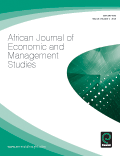The purpose of this paper is to investigate how credit access affects the welfare of households and sheds light on how household characteristics influence the decision to take credit and the efficiency in credit use. Design/methodology/approach This study uses data from the fourth round of the Ethiopian Rural Household Survey conducted in 2009, and examines factors that determine the decision to take credit and the effect of such decision on household welfare. The household welfare variable is measured by the food security indicator and total food expenditure. The study employs endogenous Regime Switching model to account for endogeneity in access to credit and self-selection bias in the decision to participate in credit. Findings. The result from the kernel distribution shows households with access to credit have more consumption expenditure than those without access to credit. The ordinary least square regression shows that access to credit increases total consumption by 12 percent without considering self-selection bias. Participation in non-farm activity increases the demand for credit by 17 percent. Land holding, household size, and participation in saving associations increase the probability of getting credit by 5, 11, and 20 percent, respectively. Access to credit appears to have a positive impact on food security in both actual and counterfactual cases for the current credit receivers. Originality/value. This study provides a thorough analysis of the impacts of access to credit on household welfare in Ethiopia. The study contributes to the debate on the link between access to credit and household welfare and provides valuable input for policy makers.
Does access to credit improve household welfare? Evidence from Ethiopia using endogenous regime switching regression.
Citation: Bocher, T.; Alemu, B.A.; Kelbore, Z.G. 2017. Does access to credit improve household welfare? Evidence from Ethiopia using endogenous regime switching regression. African Journal of Economic and Management Studies. (UK). ISSN 2040-0705. 8(1). pp. 51-65.
2018-05-29
FOOD SECURITY, FOOD SYSTEMS, INCLUSIVE GROWTH
Eastern Africa
Ethiopia
journal_article

